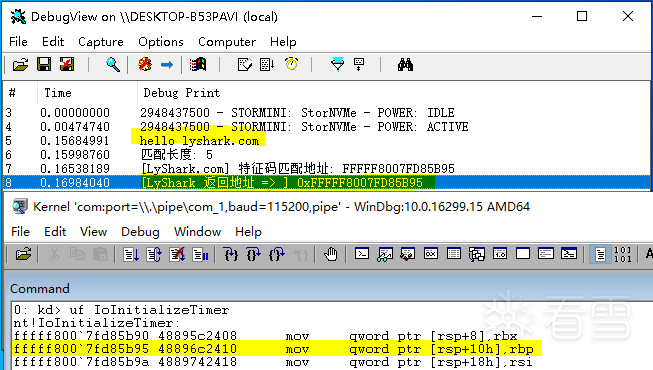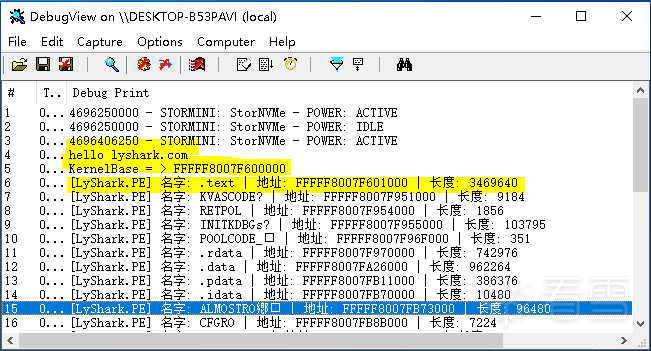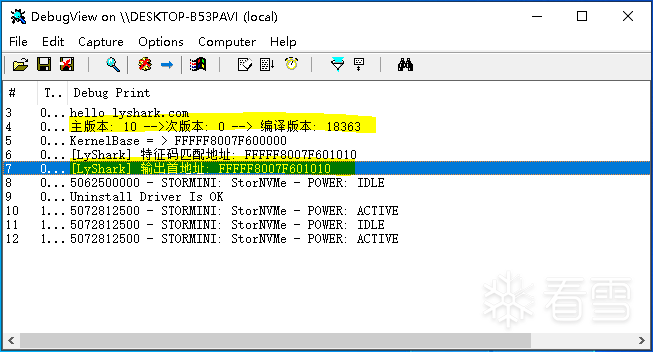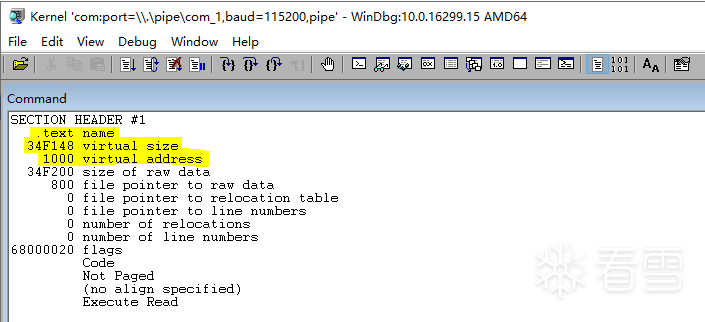编程技术- 驱动开发:内核特征码扫描PE代码段
推荐 原创在笔者上一篇文章《驱动开发:内核特征码搜索函数封装》中为了定位特征的方便我们封装实现了一个可以传入数组实现的SearchSpecialCode定位函数,该定位函数其实还不能算的上简单,本章LyShark将对特征码定位进行简化,让定位变得更简单,并运用定位代码实现扫描内核PE的.text代码段,并从代码段中得到某个特征所在内存位置。
老样子为了后续教程能够继续,先来定义一个lyshark.h头文件,该头文件中包含了我们本篇文章所必须要使用到的结构体定义,这些定义的函数如果不懂请去看LyShark以前的文章,这里就不罗嗦了。
|
1
2
3
4
5
6
7
8
9
10
11
12
13
14
15
16
17
18
19
20
21
22
23
24
25
26
27
28
29
30
31
32
33
34
35
36
37
38
39
40
41
42
43
44
45
46
47
48
49
50
51
52
53
54
55
56
57
58
59
60
61
62
63
64
65
66
67
68
69
70
71
72
73
74
75
76
77
78
79
80
81
82
83
84
85
86
87
88
89
90
91
92
93
94
95
96
97
98
99
100
101
102
103
104
105
106
107
108
109
110
111
112
113
114
115
116
117
118
119
120
121
122
123
124
125
126
127
128
129
130
131
132
133
134
135
136
137
138
139
140
141
142
143
144
145
146
147
148
149
150
151
152
153
154
155
156
157
158
159
160
161
162
163
164
165
166
167
168
169
170
171
172
173
174
175
176
177
178
179
180
181
182
183
184
185
186
187
188
189
190
191
192
193
194
195
196
197
198
199
200
201
202
203
204
205
206
207
208
209
210
211
212
213
|
#include <ntifs.h>
#include <ntimage.h>
typedef struct _KLDR_DATA_TABLE_ENTRY
{
LIST_ENTRY64 InLoadOrderLinks;
ULONG64 __Undefined1;
ULONG64 __Undefined2;
ULONG64 __Undefined3;
ULONG64 NonPagedDebugInfo;
ULONG64 DllBase;
ULONG64 EntryPoint;
ULONG SizeOfImage;
UNICODE_STRING FullDllName;
UNICODE_STRING BaseDllName;
ULONG Flags;
USHORT LoadCount;
USHORT __Undefined5;
ULONG64 __Undefined6;
ULONG CheckSum;
ULONG __padding1;
ULONG TimeDateStamp;
ULONG __padding2;
}KLDR_DATA_TABLE_ENTRY,
*
PKLDR_DATA_TABLE_ENTRY;
typedef struct _RTL_PROCESS_MODULE_INFORMATION
{
HANDLE Section;
PVOID MappedBase;
PVOID ImageBase;
ULONG ImageSize;
ULONG Flags;
USHORT LoadOrderIndex;
USHORT InitOrderIndex;
USHORT LoadCount;
USHORT OffsetToFileName;
UCHAR FullPathName[
256
];
} RTL_PROCESS_MODULE_INFORMATION,
*
PRTL_PROCESS_MODULE_INFORMATION;
typedef struct _RTL_PROCESS_MODULES
{
ULONG NumberOfModules;
RTL_PROCESS_MODULE_INFORMATION Modules[
1
];
} RTL_PROCESS_MODULES,
*
PRTL_PROCESS_MODULES;
typedef enum _SYSTEM_INFORMATION_CLASS
{
SystemBasicInformation
=
0x0
,
SystemProcessorInformation
=
0x1
,
SystemPerformanceInformation
=
0x2
,
SystemTimeOfDayInformation
=
0x3
,
SystemPathInformation
=
0x4
,
SystemProcessInformation
=
0x5
,
SystemCallCountInformation
=
0x6
,
SystemDeviceInformation
=
0x7
,
SystemProcessorPerformanceInformation
=
0x8
,
SystemFlagsInformation
=
0x9
,
SystemCallTimeInformation
=
0xa
,
SystemModuleInformation
=
0xb
,
SystemLocksInformation
=
0xc
,
SystemStackTraceInformation
=
0xd
,
SystemPagedPoolInformation
=
0xe
,
SystemNonPagedPoolInformation
=
0xf
,
SystemHandleInformation
=
0x10
,
SystemObjectInformation
=
0x11
,
SystemPageFileInformation
=
0x12
,
SystemVdmInstemulInformation
=
0x13
,
SystemVdmBopInformation
=
0x14
,
SystemFileCacheInformation
=
0x15
,
SystemPoolTagInformation
=
0x16
,
SystemInterruptInformation
=
0x17
,
SystemDpcBehaviorInformation
=
0x18
,
SystemFullMemoryInformation
=
0x19
,
SystemLoadGdiDriverInformation
=
0x1a
,
SystemUnloadGdiDriverInformation
=
0x1b
,
SystemTimeAdjustmentInformation
=
0x1c
,
SystemSummaryMemoryInformation
=
0x1d
,
SystemMirrorMemoryInformation
=
0x1e
,
SystemPerformanceTraceInformation
=
0x1f
,
SystemObsolete0
=
0x20
,
SystemExceptionInformation
=
0x21
,
SystemCrashDumpStateInformation
=
0x22
,
SystemKernelDebuggerInformation
=
0x23
,
SystemContextSwitchInformation
=
0x24
,
SystemRegistryQuotaInformation
=
0x25
,
SystemExtendServiceTableInformation
=
0x26
,
SystemPrioritySeperation
=
0x27
,
SystemVerifierAddDriverInformation
=
0x28
,
SystemVerifierRemoveDriverInformation
=
0x29
,
SystemProcessorIdleInformation
=
0x2a
,
SystemLegacyDriverInformation
=
0x2b
,
SystemCurrentTimeZoneInformation
=
0x2c
,
SystemLookasideInformation
=
0x2d
,
SystemTimeSlipNotification
=
0x2e
,
SystemSessionCreate
=
0x2f
,
SystemSessionDetach
=
0x30
,
SystemSessionInformation
=
0x31
,
SystemRangeStartInformation
=
0x32
,
SystemVerifierInformation
=
0x33
,
SystemVerifierThunkExtend
=
0x34
,
SystemSessionProcessInformation
=
0x35
,
SystemLoadGdiDriverInSystemSpace
=
0x36
,
SystemNumaProcessorMap
=
0x37
,
SystemPrefetcherInformation
=
0x38
,
SystemExtendedProcessInformation
=
0x39
,
SystemRecommendedSharedDataAlignment
=
0x3a
,
SystemComPlusPackage
=
0x3b
,
SystemNumaAvailableMemory
=
0x3c
,
SystemProcessorPowerInformation
=
0x3d
,
SystemEmulationBasicInformation
=
0x3e
,
SystemEmulationProcessorInformation
=
0x3f
,
SystemExtendedHandleInformation
=
0x40
,
SystemLostDelayedWriteInformation
=
0x41
,
SystemBigPoolInformation
=
0x42
,
SystemSessionPoolTagInformation
=
0x43
,
SystemSessionMappedViewInformation
=
0x44
,
SystemHotpatchInformation
=
0x45
,
SystemObjectSecurityMode
=
0x46
,
SystemWatchdogTimerHandler
=
0x47
,
SystemWatchdogTimerInformation
=
0x48
,
SystemLogicalProcessorInformation
=
0x49
,
SystemWow64SharedInformationObsolete
=
0x4a
,
SystemRegisterFirmwareTableInformationHandler
=
0x4b
,
SystemFirmwareTableInformation
=
0x4c
,
SystemModuleInformationEx
=
0x4d
,
SystemVerifierTriageInformation
=
0x4e
,
SystemSuperfetchInformation
=
0x4f
,
SystemMemoryListInformation
=
0x50
,
SystemFileCacheInformationEx
=
0x51
,
SystemThreadPriorityClientIdInformation
=
0x52
,
SystemProcessorIdleCycleTimeInformation
=
0x53
,
SystemVerifierCancellationInformation
=
0x54
,
SystemProcessorPowerInformationEx
=
0x55
,
SystemRefTraceInformation
=
0x56
,
SystemSpecialPoolInformation
=
0x57
,
SystemProcessIdInformation
=
0x58
,
SystemErrorPortInformation
=
0x59
,
SystemBootEnvironmentInformation
=
0x5a
,
SystemHypervisorInformation
=
0x5b
,
SystemVerifierInformationEx
=
0x5c
,
SystemTimeZoneInformation
=
0x5d
,
SystemImageFileExecutionOptionsInformation
=
0x5e
,
SystemCoverageInformation
=
0x5f
,
SystemPrefetchPatchInformation
=
0x60
,
SystemVerifierFaultsInformation
=
0x61
,
SystemSystemPartitionInformation
=
0x62
,
SystemSystemDiskInformation
=
0x63
,
SystemProcessorPerformanceDistribution
=
0x64
,
SystemNumaProximityNodeInformation
=
0x65
,
SystemDynamicTimeZoneInformation
=
0x66
,
SystemCodeIntegrityInformation
=
0x67
,
SystemProcessorMicrocodeUpdateInformation
=
0x68
,
SystemProcessorBrandString
=
0x69
,
SystemVirtualAddressInformation
=
0x6a
,
SystemLogicalProcessorAndGroupInformation
=
0x6b
,
SystemProcessorCycleTimeInformation
=
0x6c
,
SystemStoreInformation
=
0x6d
,
SystemRegistryAppendString
=
0x6e
,
SystemAitSamplingValue
=
0x6f
,
SystemVhdBootInformation
=
0x70
,
SystemCpuQuotaInformation
=
0x71
,
SystemNativeBasicInformation
=
0x72
,
SystemErrorPortTimeouts
=
0x73
,
SystemLowPriorityIoInformation
=
0x74
,
SystemBootEntropyInformation
=
0x75
,
SystemVerifierCountersInformation
=
0x76
,
SystemPagedPoolInformationEx
=
0x77
,
SystemSystemPtesInformationEx
=
0x78
,
SystemNodeDistanceInformation
=
0x79
,
SystemAcpiAuditInformation
=
0x7a
,
SystemBasicPerformanceInformation
=
0x7b
,
SystemQueryPerformanceCounterInformation
=
0x7c
,
SystemSessionBigPoolInformation
=
0x7d
,
SystemBootGraphicsInformation
=
0x7e
,
SystemScrubPhysicalMemoryInformation
=
0x7f
,
SystemBadPageInformation
=
0x80
,
SystemProcessorProfileControlArea
=
0x81
,
SystemCombinePhysicalMemoryInformation
=
0x82
,
SystemEntropyInterruptTimingInformation
=
0x83
,
SystemConsoleInformation
=
0x84
,
SystemPlatformBinaryInformation
=
0x85
,
SystemThrottleNotificationInformation
=
0x86
,
SystemHypervisorProcessorCountInformation
=
0x87
,
SystemDeviceDataInformation
=
0x88
,
SystemDeviceDataEnumerationInformation
=
0x89
,
SystemMemoryTopologyInformation
=
0x8a
,
SystemMemoryChannelInformation
=
0x8b
,
SystemBootLogoInformation
=
0x8c
,
SystemProcessorPerformanceInformationEx
=
0x8d
,
SystemSpare0
=
0x8e
,
SystemSecureBootPolicyInformation
=
0x8f
,
SystemPageFileInformationEx
=
0x90
,
SystemSecureBootInformation
=
0x91
,
SystemEntropyInterruptTimingRawInformation
=
0x92
,
SystemPortableWorkspaceEfiLauncherInformation
=
0x93
,
SystemFullProcessInformation
=
0x94
,
SystemKernelDebuggerInformationEx
=
0x95
,
SystemBootMetadataInformation
=
0x96
,
SystemSoftRebootInformation
=
0x97
,
SystemElamCertificateInformation
=
0x98
,
SystemOfflineDumpConfigInformation
=
0x99
,
SystemProcessorFeaturesInformation
=
0x9a
,
SystemRegistryReconciliationInformation
=
0x9b
,
MaxSystemInfoClass
=
0x9c
,
} SYSTEM_INFORMATION_CLASS;
/
/
声明函数
/
/
By: Lyshark.com
NTSYSAPI PIMAGE_NT_HEADERS NTAPI RtlImageNtHeader(_In_ PVOID Base);
NTSTATUS NTAPI ZwQuerySystemInformation(SYSTEM_INFORMATION_CLASS SystemInformationClass, PVOID SystemInformation, ULONG SystemInformationLength, PULONG ReturnLength);
typedef VOID(__cdecl
*
PMiProcessLoaderEntry)(PKLDR_DATA_TABLE_ENTRY section, IN LOGICAL Insert);
typedef NTSTATUS(
*
NTQUERYSYSTEMINFORMATION)(IN ULONG SystemInformationClass, OUT PVOID SystemInformation, IN ULONG_PTR SystemInformationLength, OUT PULONG_PTR ReturnLength OPTIONAL);
|
我们继续,首先实现特征码字符串的解析与扫描实现此处UtilLySharkSearchPattern函数就是LyShark封装过的,这里依次介绍一下参数传递的含义。
- pattern 用于传入一段字符串特征值
(以\x开头) - len 代表输入特征码长度
(除去\x后的长度) - base 代表扫描内存的基地址
- size 代表需要向下扫描的长度
- ppFound 代表扫描到首地址以后返回的内存地址
这段代码该如何使用,如下我们以定位IoInitializeTimer为例,演示UtilLySharkSearchPattern如何定位特征的,如下代码pattern变量中就是我们需要定位的特征值,pattern_size则是需要定位的特征码长度,在address地址位置向下扫描128字节,找到则返回到find_address变量内。
|
1
2
3
4
5
6
7
8
9
10
11
12
13
14
15
16
17
18
19
20
21
22
23
24
25
26
27
28
29
30
31
32
33
34
35
36
37
38
39
40
41
42
43
44
45
46
47
48
49
50
51
52
53
54
55
56
57
58
59
60
61
62
63
64
65
66
67
68
69
70
71
72
73
74
75
76
77
78
79
80
81
82
83
84
85
86
87
|
/
/
署名
/
/
PowerBy: LyShark
/
/
Email: me@lyshark.com
#include "lyshark.h"
PVOID GetIoInitializeTimerAddress()
{
PVOID VariableAddress
=
0
;
UNICODE_STRING uioiTime
=
{
0
};
RtlInitUnicodeString(&uioiTime, L
"IoInitializeTimer"
);
VariableAddress
=
(PVOID)MmGetSystemRoutineAddress(&uioiTime);
if
(VariableAddress !
=
0
)
{
return
VariableAddress;
}
return
0
;
}
/
/
对指定内存执行特征码扫描
NTSTATUS UtilLySharkSearchPattern(IN PUCHAR pattern, IN ULONG_PTR
len
, IN const VOID
*
base, IN ULONG_PTR size, OUT PVOID
*
ppFound)
{
/
/
计算匹配长度
/
/
LyShark.com 特征码扫描
NT_ASSERT(ppFound !
=
0
&& pattern !
=
0
&& base !
=
0
);
if
(ppFound
=
=
0
|| pattern
=
=
0
|| base
=
=
0
)
{
return
STATUS_INVALID_PARAMETER;
}
__try
{
for
(ULONG_PTR i
=
0
; i < size
-
len
; i
+
+
)
{
BOOLEAN found
=
TRUE;
for
(ULONG_PTR j
=
0
; j <
len
; j
+
+
)
{
if
(pattern[j] !
=
((PUCHAR)base)[i
+
j])
{
found
=
FALSE;
break
;
}
}
if
(found !
=
FALSE)
{
*
ppFound
=
(PUCHAR)base
+
i;
DbgPrint(
"[LyShark.com] 特征码匹配地址: %p \n"
, (PUCHAR)base
+
i);
return
STATUS_SUCCESS;
}
}
}
__except (EXCEPTION_EXECUTE_HANDLER)
{
return
STATUS_UNHANDLED_EXCEPTION;
}
return
STATUS_NOT_FOUND;
}
VOID UnDriver(PDRIVER_OBJECT driver)
{
DbgPrint((
"Uninstall Driver Is OK \n"
));
}
NTSTATUS DriverEntry(IN PDRIVER_OBJECT Driver, PUNICODE_STRING RegistryPath)
{
DbgPrint((
"hello lyshark.com \n"
));
/
/
返回匹配长度
5
CHAR pattern[]
=
"\x48\x89\x6c\x24\x10"
;
PVOID
*
find_address
=
NULL;
int
pattern_size
=
sizeof(pattern)
-
1
;
DbgPrint(
"匹配长度: %d \n"
, pattern_size);
/
/
得到基地址
PVOID address
=
GetIoInitializeTimerAddress();
/
/
扫描特征
NTSTATUS nt
=
UtilLySharkSearchPattern((PUCHAR)pattern, pattern_size, address,
128
, &find_address);
DbgPrint(
"[LyShark 返回地址 => ] 0x%p \n"
, (ULONG64)find_address);
Driver
-
>DriverUnload
=
UnDriver;
return
STATUS_SUCCESS;
}
|
运行驱动程序完成特征定位,并对比定位效果。

如上述所示定位函数我们已经封装好了,相信你也能感受到这种方式要比使用数组更方便,为了能定位到内核PE结构我们需要使用RtlImageNtHeader来解析,这个内核函数专门用来得到内核程序的PE头部结构的,在下方案例中首先我们使用封装过的LySharkToolsUtilKernelBase函数拿到内核基址,如果你不懂函数实现细节请阅读《驱动开发:内核取ntoskrnl模块基地址》这篇文章,拿到基址以后可以直接使用RtlImageNtHeader对其PE头部进行解析,如下所示。
|
1
2
3
4
5
6
7
8
9
10
11
12
13
14
15
16
17
18
19
20
21
22
23
24
25
26
27
28
29
30
31
32
33
34
35
36
37
38
39
40
41
42
43
44
45
46
47
48
49
50
51
52
53
54
55
56
57
58
59
60
61
62
63
64
65
66
67
68
69
70
71
72
73
74
75
76
77
78
79
80
81
82
83
84
85
86
87
88
89
90
91
92
93
94
95
96
97
98
99
100
101
102
103
104
105
106
107
108
109
110
111
112
113
114
|
/
/
署名
/
/
PowerBy: LyShark
/
/
Email: me@lyshark.com
#include "lyshark.h"
/
/
定义全局变量
static PVOID g_KernelBase
=
0
;
static ULONG g_KernelSize
=
0
;
/
/
得到KernelBase基地址
/
/
lyshark.com
PVOID LySharkToolsUtilKernelBase(OUT PULONG pSize)
{
NTSTATUS status
=
STATUS_SUCCESS;
ULONG bytes
=
0
;
PRTL_PROCESS_MODULES pMods
=
0
;
PVOID checkPtr
=
0
;
UNICODE_STRING routineName;
if
(g_KernelBase !
=
0
)
{
if
(pSize)
{
*
pSize
=
g_KernelSize;
}
return
g_KernelBase;
}
RtlInitUnicodeString(&routineName, L
"NtOpenFile"
);
checkPtr
=
MmGetSystemRoutineAddress(&routineName);
if
(checkPtr
=
=
0
)
return
0
;
__try
{
status
=
ZwQuerySystemInformation(SystemModuleInformation,
0
, bytes, &bytes);
if
(bytes
=
=
0
)
{
return
0
;
}
pMods
=
(PRTL_PROCESS_MODULES)ExAllocatePoolWithTag(NonPagedPoolNx, bytes, L
"LyShark"
);
RtlZeroMemory(pMods, bytes);
status
=
ZwQuerySystemInformation(SystemModuleInformation, pMods, bytes, &bytes);
if
(NT_SUCCESS(status))
{
PRTL_PROCESS_MODULE_INFORMATION pMod
=
pMods
-
>Modules;
for
(ULONG i
=
0
; i < pMods
-
>NumberOfModules; i
+
+
)
{
if
(checkPtr >
=
pMod[i].ImageBase && checkPtr < (PVOID)((PUCHAR)pMod[i].ImageBase
+
pMod[i].ImageSize))
{
g_KernelBase
=
pMod[i].ImageBase;
g_KernelSize
=
pMod[i].ImageSize;
if
(pSize)
{
*
pSize
=
g_KernelSize;
}
break
;
}
}
}
}
__except (EXCEPTION_EXECUTE_HANDLER)
{
return
0
;
}
if
(pMods)
{
ExFreePoolWithTag(pMods, L
"LyShark"
);
}
DbgPrint(
"KernelBase = > %p \n"
, g_KernelBase);
return
g_KernelBase;
}
VOID UnDriver(PDRIVER_OBJECT driver)
{
DbgPrint((
"Uninstall Driver Is OK \n"
));
}
NTSTATUS DriverEntry(IN PDRIVER_OBJECT Driver, PUNICODE_STRING RegistryPath)
{
DbgPrint((
"hello lyshark.com \n"
));
/
/
获取内核第一个模块的基地址
PVOID base
=
LySharkToolsUtilKernelBase(
0
);
if
(!base)
return
STATUS_NOT_FOUND;
/
/
得到NT头部PE32
+
结构
/
/
lyshark.com
PIMAGE_NT_HEADERS64 pHdr
=
RtlImageNtHeader(base);
if
(!pHdr)
return
STATUS_INVALID_IMAGE_FORMAT;
/
/
首先寻找代码段
PIMAGE_SECTION_HEADER pFirstSection
=
(PIMAGE_SECTION_HEADER)(pHdr
+
1
);
for
(PIMAGE_SECTION_HEADER pSection
=
pFirstSection; pSection < pFirstSection
+
pHdr
-
>FileHeader.NumberOfSections; pSection
+
+
)
{
ANSI_STRING LySharkSection, LySharkName;
RtlInitAnsiString(&LySharkSection,
".text"
);
RtlInitAnsiString(&LySharkName, (PCCHAR)pSection
-
>Name);
DbgPrint(
"[LyShark.PE] 名字: %Z | 地址: %p | 长度: %d \n"
, LySharkName, (PUCHAR)base
+
pSection
-
>VirtualAddress, pSection
-
>Misc.VirtualSize);
}
Driver
-
>DriverUnload
=
UnDriver;
return
STATUS_SUCCESS;
}
|
运行这段驱动程序,你会得到当前内核的所有PE节信息,枚举效果如下所示。

既然能够得到PE头部数据了,那么我们只需要扫描这段空间并得到匹配到的数据即可,其实很容易实现,如下代码所示。
|
1
2
3
4
5
6
7
8
9
10
11
12
13
14
15
16
17
18
19
20
21
22
23
24
25
26
27
28
29
30
31
32
33
34
35
36
37
38
39
40
41
42
43
44
45
46
47
48
49
50
51
52
53
54
55
56
57
58
59
60
61
62
63
64
65
66
67
68
69
70
71
72
73
74
75
76
77
78
79
80
81
82
83
84
85
86
87
88
89
90
91
92
93
94
95
96
97
98
99
100
101
102
103
104
105
106
107
108
109
110
111
112
113
114
115
116
117
118
119
120
121
122
123
124
125
126
127
128
129
130
131
132
133
134
135
136
137
138
139
140
141
142
143
144
145
146
147
148
149
150
151
152
153
154
155
156
157
158
159
160
161
162
163
164
165
166
167
168
169
170
171
172
173
174
175
176
177
178
179
180
181
182
183
184
185
186
187
188
189
|
/
/
署名
/
/
PowerBy: LyShark
/
/
Email: me@lyshark.com
#include "lyshark.h"
/
/
定义全局变量
static PVOID g_KernelBase
=
0
;
static ULONG g_KernelSize
=
0
;
/
/
得到KernelBase基地址
/
/
lyshark.com
PVOID LySharkToolsUtilKernelBase(OUT PULONG pSize)
{
NTSTATUS status
=
STATUS_SUCCESS;
ULONG bytes
=
0
;
PRTL_PROCESS_MODULES pMods
=
0
;
PVOID checkPtr
=
0
;
UNICODE_STRING routineName;
if
(g_KernelBase !
=
0
)
{
if
(pSize)
{
*
pSize
=
g_KernelSize;
}
return
g_KernelBase;
}
RtlInitUnicodeString(&routineName, L
"NtOpenFile"
);
checkPtr
=
MmGetSystemRoutineAddress(&routineName);
if
(checkPtr
=
=
0
)
return
0
;
__try
{
status
=
ZwQuerySystemInformation(SystemModuleInformation,
0
, bytes, &bytes);
if
(bytes
=
=
0
)
{
return
0
;
}
pMods
=
(PRTL_PROCESS_MODULES)ExAllocatePoolWithTag(NonPagedPoolNx, bytes, L
"LyShark"
);
RtlZeroMemory(pMods, bytes);
status
=
ZwQuerySystemInformation(SystemModuleInformation, pMods, bytes, &bytes);
if
(NT_SUCCESS(status))
{
PRTL_PROCESS_MODULE_INFORMATION pMod
=
pMods
-
>Modules;
for
(ULONG i
=
0
; i < pMods
-
>NumberOfModules; i
+
+
)
{
if
(checkPtr >
=
pMod[i].ImageBase && checkPtr < (PVOID)((PUCHAR)pMod[i].ImageBase
+
pMod[i].ImageSize))
{
g_KernelBase
=
pMod[i].ImageBase;
g_KernelSize
=
pMod[i].ImageSize;
if
(pSize)
{
*
pSize
=
g_KernelSize;
}
break
;
}
}
}
}
__except (EXCEPTION_EXECUTE_HANDLER)
{
return
0
;
}
if
(pMods)
{
ExFreePoolWithTag(pMods, L
"LyShark"
);
}
DbgPrint(
"KernelBase = > %p \n"
, g_KernelBase);
return
g_KernelBase;
}
/
/
对指定内存执行特征码扫描
NTSTATUS UtilLySharkSearchPattern(IN PUCHAR pattern, IN UCHAR wildcard, IN ULONG_PTR
len
, IN const VOID
*
base, IN ULONG_PTR size, OUT PVOID
*
ppFound)
{
NT_ASSERT(ppFound !
=
0
&& pattern !
=
0
&& base !
=
0
);
if
(ppFound
=
=
0
|| pattern
=
=
0
|| base
=
=
0
)
{
return
STATUS_INVALID_PARAMETER;
}
__try
{
for
(ULONG_PTR i
=
0
; i < size
-
len
; i
+
+
)
{
BOOLEAN found
=
TRUE;
for
(ULONG_PTR j
=
0
; j <
len
; j
+
+
)
{
if
(pattern[j] !
=
wildcard && pattern[j] !
=
((PUCHAR)base)[i
+
j])
{
found
=
FALSE;
break
;
}
}
if
(found !
=
FALSE)
{
*
ppFound
=
(PUCHAR)base
+
i;
DbgPrint(
"[LyShark] 特征码匹配地址: %p \n"
, (PUCHAR)base
+
i);
return
STATUS_SUCCESS;
}
}
}
__except (EXCEPTION_EXECUTE_HANDLER)
{
return
STATUS_UNHANDLED_EXCEPTION;
}
return
STATUS_NOT_FOUND;
}
/
/
扫描代码段中的指令片段
NTSTATUS ByLySharkComUtilScanSection(IN PCCHAR section, IN PUCHAR pattern, IN UCHAR wildcard, IN ULONG_PTR
len
, OUT PVOID
*
ppFound)
{
NT_ASSERT(ppFound !
=
0
);
if
(ppFound
=
=
0
)
return
STATUS_INVALID_PARAMETER;
/
/
获取内核第一个模块的基地址
PVOID base
=
LySharkToolsUtilKernelBase(
0
);
if
(!base)
return
STATUS_NOT_FOUND;
/
/
得到NT头部PE32
+
结构
PIMAGE_NT_HEADERS64 pHdr
=
RtlImageNtHeader(base);
if
(!pHdr)
return
STATUS_INVALID_IMAGE_FORMAT;
/
/
首先寻找代码段
PIMAGE_SECTION_HEADER pFirstSection
=
(PIMAGE_SECTION_HEADER)(pHdr
+
1
);
for
(PIMAGE_SECTION_HEADER pSection
=
pFirstSection; pSection < pFirstSection
+
pHdr
-
>FileHeader.NumberOfSections; pSection
+
+
)
{
ANSI_STRING LySharkSection, LySharkText;
RtlInitAnsiString(&LySharkSection, section);
RtlInitAnsiString(&LySharkText, (PCCHAR)pSection
-
>Name);
/
/
判断是不是我们要找的.text节
if
(RtlCompareString(&LySharkSection, &LySharkText, TRUE)
=
=
0
)
{
/
/
如果是则开始匹配特征码
return
UtilLySharkSearchPattern(pattern, wildcard,
len
, (PUCHAR)base
+
pSection
-
>VirtualAddress, pSection
-
>Misc.VirtualSize, ppFound);
}
}
return
STATUS_NOT_FOUND;
}
VOID UnDriver(PDRIVER_OBJECT driver)
{
DbgPrint((
"Uninstall Driver Is OK \n"
));
}
NTSTATUS DriverEntry(IN PDRIVER_OBJECT Driver, PUNICODE_STRING RegistryPath)
{
DbgPrint(
"hello lyshark.com \n"
);
PMiProcessLoaderEntry m_MiProcessLoaderEntry
=
NULL;
RTL_OSVERSIONINFOW Version
=
{
0
};
Version.dwOSVersionInfoSize
=
sizeof(Version);
RtlGetVersion(&Version);
/
/
获取内核版本号
DbgPrint(
"主版本: %d -->次版本: %d --> 编译版本: %d"
, Version.dwMajorVersion, Version.dwMinorVersion, Version.dwBuildNumber);
if
(Version.dwMajorVersion
=
=
10
)
{
/
/
如果是 win10
18363
则匹配特征
if
(Version.dwBuildNumber
=
=
18363
)
{
CHAR pattern[]
=
"\x48\x89\x5c\x24\x08"
;
int
pattern_size
=
sizeof(pattern)
-
1
;
ByLySharkComUtilScanSection(
".text"
, (PUCHAR)pattern,
0xCC
, pattern_size, (PVOID
*
)&m_MiProcessLoaderEntry);
DbgPrint(
"[LyShark] 输出首地址: %p"
, m_MiProcessLoaderEntry);
}
}
Driver
-
>DriverUnload
=
UnDriver;
return
STATUS_SUCCESS;
}
|
代码中首先判断系统主版本windows 10 18363如果是则执行匹配,只匹配.text也就是代码段中的数据,当遇到0xcc时则取消继续,否则继续执行枚举,程序输出效果如下所示。

在WinDBG中输入命令!dh 0xfffff8007f600000解析出内核PE头数据,可以看到如下所示,对比无误。

更多【 驱动开发:内核特征码扫描PE代码段】相关视频教程:www.yxfzedu.com
相关文章推荐
- 软件逆向-自动化提取恶意文档中的shellcode - Android安全 CTF对抗 IOS安全
- 二进制漏洞-铁威马TerraMaster CVE-2022-24990&CVE-2022-24989漏洞分析报告 - Android安全 CTF对抗 IOS安全
- 4-seccomp-bpf+ptrace实现修改系统调用原理(附demo) - Android安全 CTF对抗 IOS安全
- 二进制漏洞-Windows内核提权漏洞CVE-2018-8120分析 - Android安全 CTF对抗 IOS安全
- CTF对抗-Hack-A-Sat 2020预选赛 beckley - Android安全 CTF对抗 IOS安全
- CTF对抗-]2022KCTF秋季赛 第十题 两袖清风 - Android安全 CTF对抗 IOS安全
- CTF对抗-kctf2022 秋季赛 第十题 两袖清风 wp - Android安全 CTF对抗 IOS安全
- Pwn-(pwn零基础入门到进阶)第一章 二进制文件 & 4 动态链接 - Android安全 CTF对抗 IOS安全
- Pwn-(pwn零基础入门到进阶)第一章 二进制文件 & 3 静态链接 - Android安全 CTF对抗 IOS安全
- CTF对抗-22年12月某春秋赛题-Random_花指令_Chacha20_RC4 - Android安全 CTF对抗 IOS安全
- Pwn-(pwn零基础入门到进阶)第一章 二进制文件 & 2 ELF文件格式 - Android安全 CTF对抗 IOS安全
- Pwn-从NCTF 2022 ezshellcode入门CTF PWN中的ptrace代码注入 - Android安全 CTF对抗 IOS安全
- 编程技术-开源一个自己写的简易的windows内核hook框架 - Android安全 CTF对抗 IOS安全
- 编程技术-拦截Windows关机消息 - Android安全 CTF对抗 IOS安全
- CTF对抗-KCTF2022秋季赛 第八题 商贸往来 题解 - Android安全 CTF对抗 IOS安全
- 软件逆向-分析某游戏驱动保护的学习历程 - Android安全 CTF对抗 IOS安全
- 软件逆向-Wibu Codemeter 7.3学习笔记——Codemeter API调用及通信协议 - Android安全 CTF对抗 IOS安全
- Pwn-(pwn零基础入门到进阶)第一章 二进制文件 & 1 编译原理 - Android安全 CTF对抗 IOS安全
- Android安全-ByteCTF2022 mobile系列 - Android安全 CTF对抗 IOS安全
- Pwn-HITCON2022-wtfshell详解 - Android安全 CTF对抗 IOS安全
2):严禁色情、血腥、暴力
3):严禁发布任何形式的广告贴
4):严禁发表关于中国的政治类话题
5):严格遵守中国互联网法律法规
6):有侵权,疑问可发邮件至service@yxfzedu.com
接各种驱动定制如:游戏读写驱动,软件内存保护,防止调试等功能定制。
出租读写驱动,调试驱动,无痕注入支持各种游戏。
邮箱:service@yxfzedu.com
QQ:851920120
特别说明:不接游戏数据分析,外挂编写,登陆协议等类似业务。
